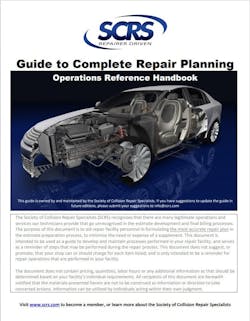When written correctly, parts code table entries are valuable when documenting damage appraisals by helping to fill in the gaps left by estimating systems. This allows a repair planner to add steps or processes to completely illustrate what the vehicle repair needs. One of the concerns I have when reviewing parts code table entries, however, is that they are too vague and often create more questions while providing less answers. A parts code table entry should define as much as possible of the who, what, why, where and how in the same manner as an estimating database repair line. The best samples I have seen are in the Society of Collision Repair Specialists (SCRS) Guide to Complete Repair Planning.
Parts code table entries should be as descriptive as possible using the least amount of words. A common error I see is a part code table entry like “Restore Corrosion Protection” which does not state clearly enough which process the repair planner expects to be performed. How many types of corrosion protection can you think of? The best part code table entry also has a line note accompanying them to provide additional explanation. When described in an entry such as “Restore cavity wax,” with a line note describing “Restore factory applied cavity wax using (product) which requires (percentage) of 12oz can to complete repair,” it removes any doubt on the repair planner’s expectations. Aligning the parts code entry on the damage appraisal under the panel that requires the cavity wax further illustrates where the product needs to be applied. Developed together, the part code table entry and the line note should thoroughly describe the process. To tie the two together, you should use the same identifier as RCW for Restore Cavity Wax for the part code entry and the line note.
|
Read the article? Get AMi credit! |
| This article is worth .25 credit hours toward Automotive Management Institute (AMi) designation programs. To receive credit, log in or set up a free "myAMi" account at ami.knowledgeanywhere.com. Then search for "Anatomy of a parts code table." |
Another common error I see in parts code table entries is in the area of structure alignment. I see manually created parts code table entries such as “Pull Rear Body” with a labor value identified. If you think for just a minute, I believe you will come up with a variety of different panels in the rear body area. In that same minute you will wonder which panel requires a pull and why, as most often this entry is found near the bottom of a damage appraisal and not really in line with an obvious repair operation. Estimating system databases have several operation choices available where you can select rear body panel and use the operation “Align” to identify the exact panel that requires the “pull.” You should accompany the database entry with a line note showing, “Rear body panel has 5mm of crush as identified in structure measurements” to explain what needs aligning and by what degree. When identifying the panel in this way, you can select adjacent panels that might also need alignment which further illustrates the repair requirements. The estimating database will also tell you the metal types involved to help you determine if the panel can be aligned which is something a manual parts code entry will not.
The key is to only create manual part code table entries when absolutely necessary and not replicate something that can be found in the estimating database. Using the database whenever possible will help you keep the repair process aligned within each specific category, as well as alert you to related operations. When creating a parts code table entry, it should mirror the typeface of the estimating database to present a consistent image. I see many entries that are in all CAPITAL letters which makes them stick out rather than blend in with the other appraisal lines. While you can and should align manual part code entries within the category that the step is required, most often I find them at the bottom portion of the appraisal. Multiple entries at the end of an appraisal will appear random and create questions to their validity or need.
Creating a parts code table can be time consuming. However, the consistency it will provide is unmeasurable towards building an informative damage appraisal. As mentioned above, clarifying the who, what, why, where and how will pay you great dividends in helping all involved understand the expectation of the repair. When your damage appraisals completely illustrate the vehicle repair requirements, you build confidence in your business and reduce secondary communications from those involved in the repair process. This confidence will foster sustainable business relationships and provide growth through customer satisfaction.




